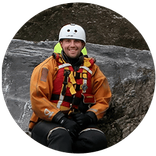Ryan's Journey - HART Paramedic

Ryan Wiltshire is a hazardous area response team (HART) paramedic who has been with EEAST for nine years.
When I joined the East of England Ambulance Service Trust (EEAST) in 2016 initially entering on the student ambulance paramedic pathway, I quickly became immersed in the world of patient care, first completing my training at Hellesdon and then studying paramedic science at the University of East Anglia.
My time in west Norfolk was an invaluable part of my development. Working in this area, I had the privilege of meeting and collaborating with some amazing colleagues. These relationships and the experiences I gained strengthened my resolve to pursue a career where I could continuously challenge myself. However, after some time, I realised I was ready to explore new opportunities within EEAST to take my skills further.
I had always wanted to join the hazardous area response team (HART). HART's primary mission of delivering paramedic-level care in challenging and sometimes hazardous environments was something that really appealed to me. Whether responding to incidents in dangerous or inaccessible locations or working in environments that required specialised personal protective equipment (PPE), the role demanded a high level of skill and adaptability.
When I joined HART in 2021, I began a rigorous training journey that would expose me to areas of emergency response I had never imagined before. My core training included essential disciplines such as extended duration breathing apparatus (EDBA), chemical, biological, radiological, and nuclear (CBRN) response, hazardous materials (HAZMAT) handling, safe working at height, high-risk confined space entry, as well as mod 3 swift water rescue technician training.
These qualifications aren’t just ‘nice to have’; they are the backbone of ensuring that HART operatives can work safely and effectively in extreme situations. The training pushed my limits and prepared me for scenarios where the stakes were high, and the environment was unpredictable. One of the highlights of my career with HART has been the opportunity to become a confined space instructor. This qualification allows me to pass on critical skills to fellow colleagues, ensuring that they are equipped with the knowledge and confidence to enter and work in confined spaces, one of the most dangerous environments paramedics can face. It's incredibly rewarding to share this knowledge and see others grow in their own roles.
Working within HART means working in small, tight-knit teams. This structure fosters an environment where trust, communication, and teamwork are essential to success. In my experience, this kind of close collaboration creates a level of camaraderie that I’ve not encountered in any other part of the ambulance service. There’s an unspoken understanding that everyone has each other’s back, and when lives are on the line, that trust is invaluable.
One of the most dynamic aspects of being part of HART is the opportunity to collaborate with professionals from other emergency services. As a HART operative, I’ve had the chance to work alongside the fire service, police, and coastguard, both during live incidents and in training exercises. This multidisciplinary approach not only improves patient outcomes but also strengthens inter-agency relationships, enhancing overall response capabilities.
As I reflect on my journey from a student paramedic to a fully qualified HART operative, I am incredibly grateful for the experiences and people who have shaped my career so far. The skills I’ve gained, the challenges I’ve faced, and the relationships I’ve built have all contributed to my passion for pre-hospital care and emergency response. I look forward to continuing to learn, grow, and face new challenges head-on in this ever-evolving profession.
If you're considering a career in the ambulance service or a specialised team like HART, it’s important to be ready for a career that is constantly changing, challenging, and incredibly rewarding.
